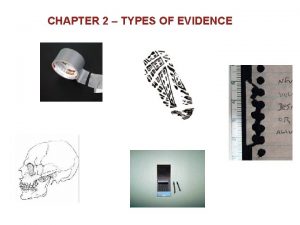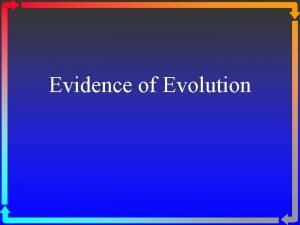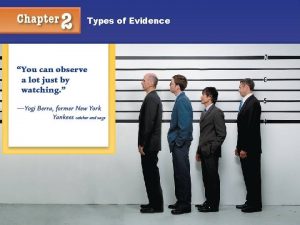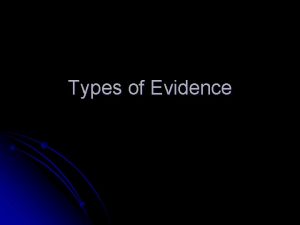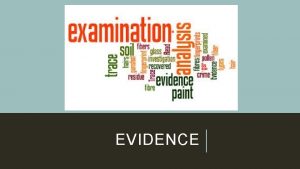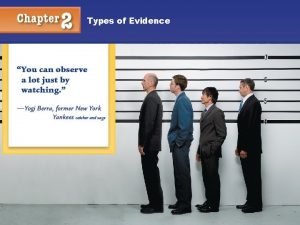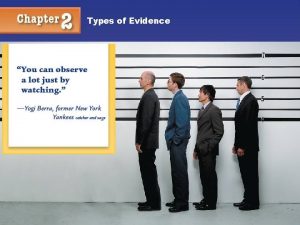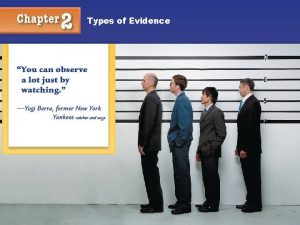CHAPTER 2 TYPES OF EVIDENCE CLASSIFICATION OF EVIDENCE











- Slides: 11

CHAPTER 2 – TYPES OF EVIDENCE

CLASSIFICATION OF EVIDENCE Testimonial evidence is a statement made under oath; also known as direct evidence or prima facie evidence. - Eyewitness accounts/Witness statements Physical evidence is any object or material that is relevant in a crime; also known as indirect evidence. Examples are hair, fiber, fingerprints, documents, blood, soil, drugs, toolmarks, impressions, glass.

EYEWITNESS ACCOUNTS Eyewitness accounts are testimonial evidence given under oath by a person who observed the incident. A police composite may be developed from the witness testimony by a computer program or forensic artist. FACES—a composite program by Inter. Quest

RELIABILITY OF EYEWITNESS Factors that affect accuracy: Nature of the offense and the situation in which the crime is observed Characteristics of the witness Manner in which the information is retrieved Additional factors: Witness’s prior relationship with the accused Length of time between the offense and the identification Any prior identification or failure to identify the defendant Any prior identification of a person other than the defendant by the eyewitness

PHYSICAL EVIDENCE As a result of the influences on eyewitness memory, physical evidence becomes critical. Is generally more reliable than testimonial evidence Can prove that a crime has been committed Can corroborate or refute testimony Can link a suspect with a victim or with a crime scene Can establish the identity of persons associated with a crime A forensic scientist compares the questioned or unknown sample from the crime scene with a sample of known or exemplar origin. Can allow reconstruction of events of a crime Physical evidence can be used to answer questions about: What took place at a crime scene The number of people involved The sequence of events

TYPES OF PHYSICAL EVIDENCE Transient evidence is temporary - easily changed or lost; usually observed by the first officer at the scene. Pattern evidence is produced by direct contact between a person and an object or between two objects. Conditional evidence is produced by a specific event or action; important in crime scene reconstruction and in determining the set of circumstances or sequence within a particular event. Transfer evidence is produced by contact between person(s) and object(s), or between person(s) and person(s). Associative evidence is something that may associate a victim or suspect with a scene or with each other; e. g. , personal belongings. —Henry C. Lee and Jerry Labriola, Famous Crimes Revisited, 2001

EXAMPLES OF TRANSIENT EVIDENCE Transient evidence is temporary - easily changed or lost; usually observed by the first officer at the scene. Odor — putrefaction, perfume, gasoline, urine, burning, explosives, cigarette or cigar smoke Temperature — surroundings, car hood, coffee, water in a bathtub, cadaver Imprints and indentations — footprints, teeth marks in perishable foods, tire marks on certain surfaces

EXAMPLES OF PATTERN EVIDENCE Pattern evidence is produced by direct contact between a person and an object or between two objects. It is mostly found in the form of imprints, indentations, striations, markings, fractures, or deposits. Blood spatter Glass fracture Fire burn pattern Furniture position Projectile trajectory Tire marks or skid marks Clothing or article distribution Gunpowder residue Material damage Body position Toolmarks Modus operandi

EXAMPLES OF CONDITIONAL EVIDENCE Conditional evidence is produced by a specific event or action; important in crime scene reconstruction and in determining the set of circumstances or sequence within a particular event. Light—headlight, lighting conditions, lights on or off Smoke—color, direction of travel, density, odor Fire—color and direction of the flames, speed of spread, temperature and condition of fire Location—of injuries or wounds, of bloodstains, of the victim’s vehicle, of weapons or cartridge cases, of broken glass Vehicles—doors locked or unlocked, windows opened or closed, radio off or on, odometer mileage Body—position and types of wounds; rigor, livor, and algor mortis Scene—condition of furniture, doors and windows, any disturbance or signs of a struggle

CLASSIFICATION OF EVIDENCE BY NATURE Biological—blood, semen, saliva, sweat, tears, hair, bone, tissues, urine, feces, animal material, insects, bacteria, fungi, botanical material Chemical—fibers, glass, soil, gunpowder, metals, minerals, narcotics, drugs, paper, ink, cosmetics, paint, plastic, lubricants, fertilizer Physical—fingerprints, footprints, shoeprints, handwriting, firearms, tire marks, toolmarks, typewriting Miscellaneous—laundry marks, voice analysis, polygraph, photography, stress evaluation, psycholinguistic analysis, vehicle identification

PHYSICAL EVIDENCE CHARACTERISTICS Individual—can be identified with a particular person or a single source Fingerprints Blood DNA Typing Class—common to a group of objects or persons
 Chapter 2 types of evidence
Chapter 2 types of evidence What is primary sources
What is primary sources Primary evidence vs secondary evidence
Primary evidence vs secondary evidence Primary evidence vs secondary evidence
Primary evidence vs secondary evidence Primary evidence vs secondary evidence
Primary evidence vs secondary evidence Jobs vancouver
Jobs vancouver Fiber evidence can have probative value.
Fiber evidence can have probative value. Class vs individual evidence
Class vs individual evidence Explain how class evidence may be useful
Explain how class evidence may be useful Class evidence vs individual evidence
Class evidence vs individual evidence The absence of evidence is not the evidence of absence
The absence of evidence is not the evidence of absence 4 types of evidence for evolution
4 types of evidence for evolution
